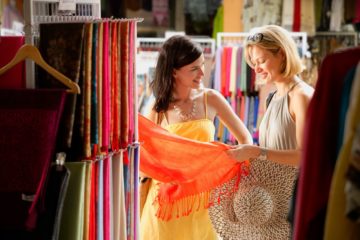In the past decade alone, social media has managed to quickly revolutionize virtually every industry in the world, and fashion and fashion journalism are certainly no exceptions. Even the world’s largest news agencies have had to transform the way their readers digest news, adding social media platforms to the forefront of their news deliveries. In the fashion world, social media has brought connectedness, innovation, and diversity to the industry. Instagram, for example, functions as a live magazine, always updating itself with the best, most current trends while allowing users to participate in fashion rather than just watch from afar.
Social media has done a number of incredible things for the fashion industry, including creating fashion icons, heavily influencing fashion trends, and ultimately reforming the way people go about seeking jobs in the field.
How Social Media Creates Fashion Icons
Traditionally, before social media, becoming a fashion icon was next to impossible. Someone in the fashion industry had to see you and think you were incredible. They had to build your brand from scratch. Unless you had fame from other experiences, your journey entailed audition after audition, deal after deal, catwalk after catwalk, and after all of which you would still only have the slightest chance of becoming a recognizable fashion figure. But social media has changed the game.
Instead of waiting for someone to discover them, users are getting themselves discovered. With new tools like Instagram, users are building their own brands and finding their own fans and followers. Instagram has given average people exposure to opportunities that they otherwise would not have. In 2015, Rihanna recruited a person to star in her music videoby sending her a direct message saying that she liked her style. New York retail agencies and brands are able to easily find self-made Instagram models that match their brand and have large followings to promote their products. Social media has allowed users to build their own online fashion communities which inevitably creates leaders of communities, and some of those communities are so large and vast that their leaders have become recognizable icons in the fashion industry.
 Social Media’s Influence on Fashion
Social Media’s Influence on Fashion
Social media has influenced the fashion industry more than any other industry. For the most part, fashion used to be a two-dimensional, one-sided industry. Brands put their clothing in magazines and users consumed ideas and inspiration by flipping through the pages. Models walked in fashion shows, and users hoped and prayed that part of it would be covered on television somewhere so they could watch. The fashion industry created the trendsetters and users followed the trends. Users didn’t have a say in what they were consuming, they could only opt out of trends that they didn’t like. Social media has reframed this structure, allowing users to not only consume fashion but to also contribute to it. Here’s how.
Hash Tag
Hashtags. Hashtags. Hashtags. Who knew the pound sign could be so powerful? Using hashtags users are able to find virtually whatever trend they want with the click of a button. If someone wants to find out what scarves people are wearing this winter, they don’t wait until the newest edition of Vogue to hit the racks, they type #winterscarves into the Instagram search. Conversely, if a person thinks that other people would want to see what they are wearing, they hashtag any and every topic that they think relates to their image, brand, and style. For example, #winterscarves #millennials #californiawinter #winterfashion.
Consumers Are Contributors
Because fashion is now a two-way street, where consumers are able to be contributors, new ideas get circulated much quicker and inevitably change faster. Consumers are able to have a front row seat at the highest levels of fashion. Snapchat, for example, gives users an intimate view of major fashion events like the MET Gala, red carpets, and various fashion weeks all over the world.
Fashion Hacks
There’s an ongoing discussion amongst the peoples of the internet, that middle schoolers today look much less awkward than they used to. This is in part because pre-teens have more examples of how to be fashionable and are given access to hacks that show preteens that they don’t have to be rich to have style. While the youth of the early 2000s anxiously waited for their Limited Too magazines to arrive in the mail in hopes that parents would purchase a single item, today’s young fashionistas know that they don’t have to have access to exclusive content to be fashion-conscious. Social media is full of little tricks and tips on how to stay fashionable in an affordable way. This phenomenon showed itself in an uglier form with the #KylieJennerChallenge where preteens everywhere were trying to suction cup their lips to a bigger size.
Celebrity Endorsements
In times before social media, celebrity endorsements ultimately happened in a few limited ways: commercials, interviews, and public stunts. All very effective, but limited nonetheless. These days, celebrities are able to endorse products on their Facebook pages, Instagram profiles, and Snapchat stories. And boy, oh boy, do users gobble it up. The fashion industry knows that if they want to sell something fast, they don’t make a broadcast television commercial, they get a Kardashian to tweet about it ASAP.
Tagging Brands
Remember when you would watch a delicious food commercial and wish that you could have the food instantly? Social media has brought us closer to this idea. On Instagram, users often tag the brands that they are wearing so that other users can find it and order it with ease from retail agencies in NYC and stores all over the world.
Diversity
More than anything, social media has brought diversity to the industry. People who have felt unrepresented in traditional forms of fashion media now have the opportunity to take matters into their own hands. They get to follow who they want to follow and it is much easier to find people who they relate to in terms of body image and lifestyle. Specifically, people of color and plus-sized who have previously had trouble spotting trends that fit them in mainstream magazines are able to find online communities through social media.
 What Social Media Means for Jobs in the Fashion Industry
What Social Media Means for Jobs in the Fashion Industry
The most important impact that social media has had on the fashion industry is perhaps the job opportunities it has added to the field, whether that be with New York retail agencies or working with designers.
- Social media has become a standard part of a resume, in virtually every industry. When filling out a job application, it is not strange for employers to ask for Instagram and Facebook profiles and Twitter handles. Companies recognize that this is one of the best ways to figure out who a person is, what they love, what they’re good at, and what they believe in. This is especially true in the fashion industry, as companies want to see if you fit their look and their brand.

- Indie designers no longer have to rely on their friends and family to get the word out about their product. They don’t have to go to every indie fashion market that is near their town (although these methods are still useful). They more easily are able to hire like-minded individuals to represent their company or work for them in other ways. They now also have more control over their product and can build their own brand on social media and sell their product on Etsy.
- Various brands and NYC retail agencies now have a new form of advertisement which provides online fashionistas with paying work, great free products, and brand exposure.
Social media has had a radical effect on essentially every aspect of the fashion industry, and while that impact may change in the future, it’s clear that it’s not going anywhere anytime soon. The largest news agencies to the top retail agencies in NY, like The Fashion Network, are leveraging social media to interact with an ever-growing community of plugged-in consumers and job seekers.
Contact Us Today





